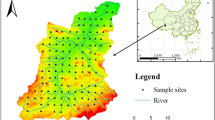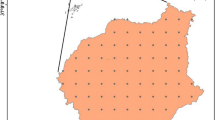Abstract
To explore spatial and temporal variability of Arsenic (As) pollution and its stability of the soil in the Juzhang River basin, the data of 255 surface soil samples are analyzed in the study area. The analysis methods include Moran’s I, the semi-variant function, the inverse distance interpolation method and the superposition analysis. The results showed that: (1) in 2006 and 2016, the average content of arsenic in soil was 1.17–48.55 mg∙kg−1 and 4.16–89.50 mg∙kg−1, only a few samples exceeded the risk screening value (GB15618-2018), but not exceeded risk intervention value. (2) The soil As was positively correlated with the space in 2006 and 2016, and the distribution of As of soil was more obvious in 2016; the spatial continuity of As of soil is stronger in 2016 than that in 2006, and the space self-correlation range in 2016 was larger than in 2006. The spatial difference of As in different directions is different, and the distribution of As pollution in the soil has slight diffusion and weighting tendency, which is closely related to the distribution of the enterprises. (3) The soil stability in the southeast is lower, and the stability of the soil in the west is relatively high; the lower the soil stability is, the larger variations the pollution space have. However, the relationship between the degree of the soil As pollution and the stability of the soil is uncertain.







Similar content being viewed by others
References
Chandra R, Prusty BAK, Azeez PA (2014) Spatial variability and temporal changes in the trace metal content of soils: implications for mine restoration plan. Environ Monit Assess 186:3661–3671
Chen HM (2018) Environmental soil science, 3rd edn. Science Press, Beijing, pp 33–35
Cui XY, Qin JH, Li ZM (2017) Accumulation and subcellular distribution of arsenic in water spinach (Ipomoea aquatica) cultivars from arsenic contaminated soil. J Agric Environ Sci 36:24–31
Cui M, Wu C, Jiang X (2019) Bibliometric analysis of research on soil arsenic during 2005–2016. J Cent South Univ 26:479–488
Dumat C, Pierart A, Shahid M (2018) Collective conceptualization and management of risk for arsenic pollution in urban community gardens. Rev Agric Food Environ Stud 99:167–187
Feng YJ, Chen LJ, Chen XJ (2019) The impact of spatial scale on local Moran’s I clustering of annual fishing effort for Dosidicusgigas offshore Peru. J OceanolLimnol 37:330–343
Fu YY, Jiang P, Liu AH (2019) Geostatistical analysis of the aspatial distribution with different stand types of Diaspidiotusslavonicus. J Northwest For Coll 34:187–193
Li CZ, Ou XH, Zhang CL (2018) Analysis of heavy metal pollution and spatial variability in farmland along the Huanjiang River. J Jiangxi AgricUniv 40:1348–1356
Luo T, Sun JX, Xia K (2017) Review on the study of soil arsenic pollution. Environ Dev 29:11–12
Qin ZH, Shi HD, Wang MH (2018) Spatial distribution and correlation of soil cadmium contamination in Xiangjiang River Tributary Basin of China. Environ Sci Res 31:1399–1406
Rajendra H, Bardhan G, Niranjana KV, Bhaskar BP (2019) Spatial variability and mapping of selected soil properties in KaligaudanahalliMicrowatershed. SN ApplSci 1:1–15
Wang H, Liu XM, Liu F (2019) Spatial distribution and pollution assessment of as at a small scale in agricultural soils of the karst region. Environ Sci 40:2895–2903
Wei J, Zheng XG, Wang CL (2019) Soil arsenic content and environmental quality assessment in the upstream basin of Guanting Reservoir and Miyun Reservoir. Environ Chem 38:71–77
Wu C, Huang J, Minasny B et al (2017) Two-dimensional empirical mode decomposition of heavy metal spatial variation in agricultural soils, Southeast China. Environ SciPollut Res 24:8302–8314
Ye LP, Tan WF, Fang LC (2019) Research advances in spatial variability of soil aggregate by using geostatistics. Sci Soil Water Conserv China 17:146–156
Zang L, Zhang GJ, Zhang H (2017) Assessment on spatial variability and pollution of the heavy metal in soil of Huanghua City. Soil Water Conserv Res 24:337–342
Acknowledgements
This article is funded by Shandong Provincial Natural Science Foundation (ZR2017MD009) and National Natural Science Foundation of China (No. 41202165, No.41102149).
Author information
Authors and Affiliations
Corresponding authors
Additional information
Publisher's Note
Springer Nature remains neutral with regard to jurisdictional claims in published maps and institutional affiliations.
Rights and permissions
About this article
Cite this article
Jiaguo, R., Bin, W., Qianqian, W. et al. Temporal and spatial variability and stability evaluation of soil arsenic pollution in Juzhang River basin. Environ Earth Sci 80, 287 (2021). https://doi.org/10.1007/s12665-021-09547-0
Received:
Accepted:
Published:
DOI: https://doi.org/10.1007/s12665-021-09547-0




